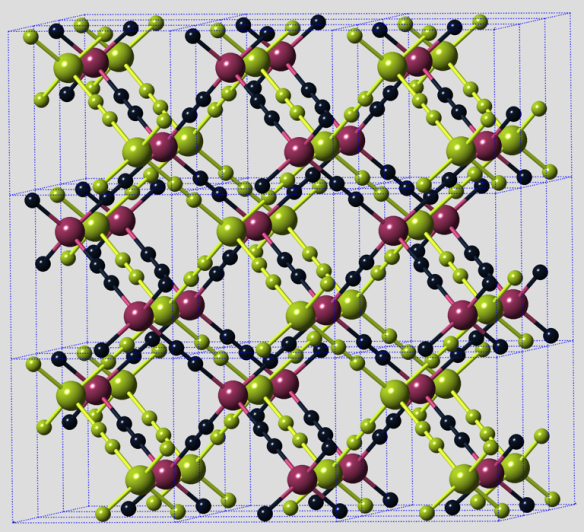The beauty within – Zinc cyanide
What does it look like?

Picture generated with CrystalMaker (http://crystalmaker.com).
Zinc cyanide is used for electroplating of zinc, and as a catalyst for a few reactions in organic chemistry. Not very exciting … Indeed, its beauty comes not from its uses, but from the crystallographic structure itself.
In zinc cyanide, or Zn(CN)2, each zinc is surrounded by four cyanide ligands, linking it to neighboring zinc atoms. This is a geometry common to many crystals, though the results show endless variety: mathematically, there is an infinite number of ways to arrange such tetrahedra in space, called four-connected nets. Zeolitic materials (previously featured here!) are a very wide family of such structures, with 216 different frameworks known to date.
From this infinite array of possible structure, zinc cyanide adopts a particularly interesting one. It forms two interpenetrated nets, i.e. two three-dimensional frameworks with no bonds between them, but "interlocked" within each other. You can see it on the picture above, where one of the frameworks has been colored in yellow, while the other one is purple (Zn) and black (C and N). Moreover, these nets have a very familiar motif: they have the same structure as diamond! (with Zn taking the place of carbon, and C–C bonds being replaced by Zn–C–N–Zn linkage).
And there is more! Though the structure at ambient conditions described above has been known since 1945, the behavior of zinc cyanide under pressure remained a mystery until very recently. In 2013, it was shown that the behavior at high pressure (a few gigapascal) depends on the nature of the fluid used for compression. With some simple fluids, such as water and methanol, compression can lead to other structures from the family of four-connected nets. This happens with a large increase of the crystal's volume, and the penetration of the fluid inside the framework of these new structures!
You can read more about this structure here dx.doi.org/10.1021/ja401268g and here dx.doi.org/10.1021/ja4012707.






